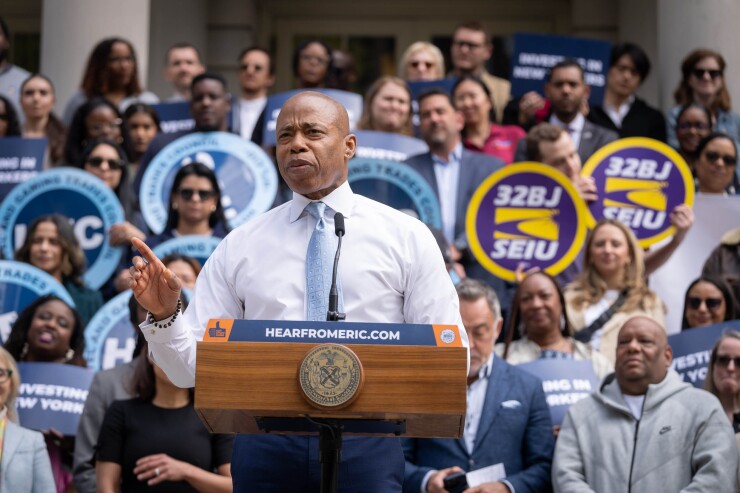Adams releases $111B balanced New York city budget plan
6 min read

New York City Mayor Eric Adams described this year’s budget process as a “herculean task.”
Adams Wednesday presented a $111 billion executive budget for fiscal 2025 that he said is balanced with minor cuts and higher-than-expected revenue, avoiding tax hikes or layoffs. The mayor stressed at a press conference that his office prepared early to fix the gap – and for the criticism that came with it.
“It’s my role as the mayor for people to criticize,” Adams said. “There’s not one savings we found that we wanted to do. We had to navigate us through and I think retrospectively people will see how we did a good job in doing so.”
Ed Reed/Mayoral Photography Office
The budget must be approved by the City Council before the fiscal year begins July 1, and its leadership says Adams does not go far enough to restore previous cuts.
“We are disappointed that critical support for key mental health services, programs to reduce recidivism, and libraries that our city desperately needs are not included in the Executive Budget,” council Speaker Adrienne Adams and Finance Chair Justin Brannan said
When budget calculations in November projected a $7 billion shortfall, Adams said his office was prepared thanks to conservative revenue forecasts and Programs to Eliminate the Gap, or PEGs, in previous years.
Still, his administration says, the Office of Management and Budget had to make up for a $1.5 billion hole left by expiring federal stimulus dollars, much of which was funding education programs.
Since the preliminary budget in January, the city found $2.3 billion in projected revenue that allowed Adams to restore some cuts to programs.
Howard Cure, director of municipal bond research for Evercore Wealth Management, said that speaks to the strength of the city’s economy.
“It’s important to stress how resilient the economy is, and it’s been this way for decades,” Cure said. “The economy is increasingly diversified. There’s a lot more tech jobs and healthcare jobs, to supplement all the other important facets of the city’s economy like finance, and education. So that always helps, to have a growing tax base.”
The extra revenue allowed the mayor to reverse some of the cuts in the preliminary budget to things like police class sizes, educational programs and cultural organizations, Cure noted.
The city also received several benefits from the recently-passed state budget, including $3 billion in assistance for costs associated with the migrant crisis, mayoral control of the schools for two more years, and renewed tax incentives for housing.
Many of the cuts that balanced the budget were controversial. Adams plan would not restore the cuts that will force libraries to only operate five or six days a week. Additionally, City Comptroller Brad Lander criticized the cuts to higher education in his overall positive statement on the budget.
“CUNY — New York’s best driver of economic mobility — is still struggling from the impact of the first two rounds of PEGs earlier this fiscal year, which continue to impact student retention, student-faculty ratios, and availability of critical programs,” Lander said. “As the Council and Mayor move toward budget adoption, I urge them to restore those cuts.”
Adams is also trying to eliminate 23,000 vacancies in the city’s early childhood education program.
The budget cut costs for the migrant crisis by $586 million, or 30%, over fiscal years 2024 and 2025. The city accomplished this, Adams said, by lowering the population of migrants under city care and renegotiating contracts that were initially made under emergency circumstances.
Adams thanked New York Governor Kathy Hochul and the legislative leadership in Albany for the $3 billion to help manage migrant costs, but complained that the city received only $196 million from the federal government.
The projections in the budget have also come under scrutiny. In the run-up to the budget’s release, the Citizens Budget Commission, a nonprofit that analyzes the city government’s finances and management, published a report suggesting that the Office of Management and Budget’s revenue projections are too conservative.
The report reflected similar criticisms from the Lander and his counterpart in the State Comptroller’s office, Thomas DiNapoli, CBC Vice President for research Ana Champeny said, noting that the city council’s revenue projections are even higher than the comptrollers’.
But Adams credits his two-year-old administration’s conservative forecasts for the city’s ability to respond to emergencies like the migrant crisis.
Conservative revenue forecasts “saved the day for us. [They are] the reason we’re having this conversation right now, being able to restore many areas and not having to do a third PEG,” Adams said.
Champeny said that argument is valid. However, she also estimates that many expenditures are under-budgeted.
Public assistance, Champeny said, is under-budgeted by “a few hundred million dollars” based on prior trends, and non-asylum seeker shelter and foster care are in a similar situation.
The city did correct some of the programs that the CBC thought were under-budgeted in its preliminary budget.
“One big area was the housing vouchers,” Champeny said. “The city program to provide city-funded housing vouchers is going to cost about $850 million this year. The budget for next year only had $170 million. In the executive budget, they did go and increase that significantly. So now next year’s budget is around $700 million. Still not quite at the current year level, but much, much closer and a much more realistic projection.”
Revenue calculations can have political motivations, Cure said. The Adams administration’s conservative revenue forecast helps justify the cuts they’re seeking, and the city council’s optimistic projections reflect that they’re less than amenable to those measures.
“Just because the mayor is making cuts or underestimating revenues doesn’t mean the City Council is working with the same numbers,” Cure said. “And the city council has been willing to fight the mayor on certain things. So this is going to be a negotiation process.”
Analysts also found a few expenditures that were not included in the budget projections.
Thanks to a state law, the city will soon have to implement mandatory class minimums in its K-12 schools. Both Cure and Champeny said the costs of this program will likely grow over time, and Champeny said it could eventually cost up to $1 billion per year.
The city may also increase eligibility for housing vouchers, Champeny said. The city council passed a policy to this effect, overriding a mayoral veto, and the policy is being litigated in court. If the expansion goes through, it could cost an additional $4 billion per year once it’s fully implemented.
Cure said it’s unclear how tax revenue from office buildings will change over the coming years, since more people have been working from home since the pandemic. It’s possible commercial real estate tax revenue will decrease more than expected, and the city may have to compensate by raising taxes on residential real estate.
DiNapoli said his office is still analyzing the budget, but had a few issues in his initial statement.
“The city continues to charge water and sewer ratepayers more to balance its budget in the outyears of its plan,” DiNapoli said. “Despite the improved revenue outlook, the city also elected not to deposit additional monies into its rainy-day fund, which underlines the lack of a systematic process to buffer against future uncertainty. The city’s reserves remain well below peers on a share of spending basis.”
John Hallacy, founder of John Hallacy Consulting, noted that in the city’s projections, debt service costs will increase from $7.3 billion in fiscal year 2024 to $10.3 billion in fiscal year 2028. The city will likely watch the market very carefully to attempt refundings that can lower those costs, Hallacy said.







